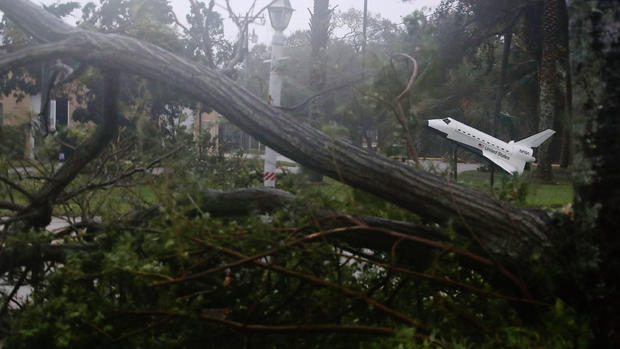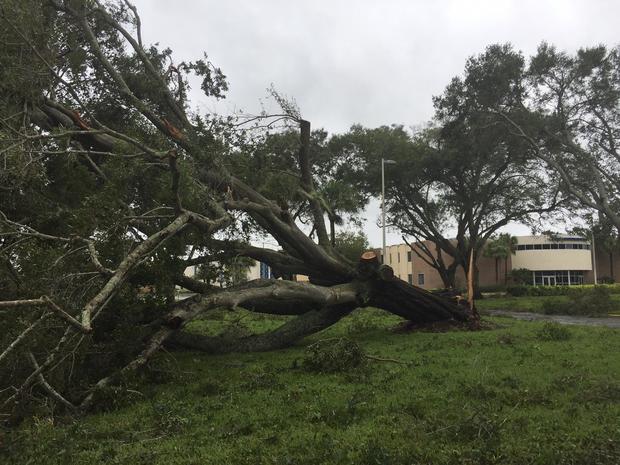Kennedy Space Center "dodged a bullet" from Hurricane Matthew
Hurricane Matthew roared along Florida’s Space Coast early Friday, bringing high winds, torrential rain and a potentially dangerous storm surge, but the hurricane’s powerful eye remained just off shore and the Category 3 storm did not appear to have the catastrophic impact on the Kennedy Space Center and its launch facilities that many had feared.
The center of Matthew’s clearly defined eye passed east of the tip of Cape Canaveral early Friday and its outer wall brushed the coastline as it moved north, brining sustained winds of 90 mph to the Kennedy Space Center, with gusts to 107 mph. Earlier forecasts called for a possible direct hit with peak winds up to 140 mph or higher.
Eight to 12 inches of rain were expected, with a storm surge of one to five feet. Earlier predictions called for a devastating surge of seven to 11 feet.
“The one thing that played into our favor somewhat is that thde center core of the hurricane was really tight, so it stayed off our coast, although it did kind of touch the tip of Cape Canaveral,” said Don Walker, a spokesman for the Brevard County Emergency Operations Center.
Because the storm wasn’t a direct hit, “it hasn’t measured up to the initial threat,” he said. “On that level, it’s good news. But the bad news is there’s still going to be damage out there, we’re going to have to rebound from this. And then we watch for the next one. There are still 53 days left in the hurricane season, so it may not be over yet.”
NASA spokesman George Diller, a member of a ride-out team monitoring critical systems at the Kennedy Space Center, said other than a few power outages, no significant damage had been noted in the storm’s immediate aftermath. A detailed inspection is planned for Saturday.
“At this time, there’s observed to be limited roof damage to KSC facilities, water and electrical utility services have been disrupted and scattered debris is observed,” he said. “Storm surge has been observed to be relatively minimal, limited to localized portions of the space center.”
But in the community bordering the space center, 183,000 Brevard County residents lost power, three house fires were reported, trees, limbs, branches and road signs were down across the area and widespread flooding was still possible due to earlier storms that left the ground saturated before Matthew made it to central Florida.
Even so, sheriff’s deputies said a preliminary look at beach communities at the southern end of Brevard County found relatively few major problems and a resident just south of the Kennedy Space Center said he had power all night and estimated the winds at tropical storm strength.
“I’m surprised at how little damage there was with a Category 3 (hurricane),” said August Werdenberg, who rode out the storm at his central Merritt Island home. “We dodged a bullet, because it went east. If it had gone west it would have been a different story.”
He had no regrets about staying at home and not evacuating, despite urgent warnings from Florida Gov. Rick Scott and emergency management personnel.
“Any regrets about staying? No,” he said. “If it had come the other way, maybe. But the way it turned out, everything was fine. I’m glad I stayed in my own home.”
Shelly Deliz, who lives a few blocks away, had no regrets about evacuating with her family to Tampa.
“I’m glad that we did,” she said. “It’s better to be safe because you just never know what will happen. It’s always better to be safe.”
Emergency management officials stood firmly by their decision to urge residents to evacuate.
“The governor did a really good job, he kept a very serious tone about what was happening, and he didn’t pull any puches,” Walker said. “It’s a dangerous situation, and people need to get out of harm’s way. Why would you put your own safety, or that of a loved one, in jeopardy when you know a storm’s coming?
The thousands of residents who did evacuate as Matthew approached Florida’s east coast faced delays getting home. The causeway bridges linking barrier island communities to the mainland, including Merritt Island, Cape Canaveral and Cocoa Beach, were closed Friday morning pending safety inspections. Officials were hopeful the bridges could be re-opened later in the day, but there were no guarantees.
Meanwhile, Matthew continued its howling trek, battering Florida’s northeast coast as it headed toward Georgia and South Carolina. The long-range forecast shows the storm eventually turning full circle and possibly heading back toward the Bahamas next week as a tropical depression.



